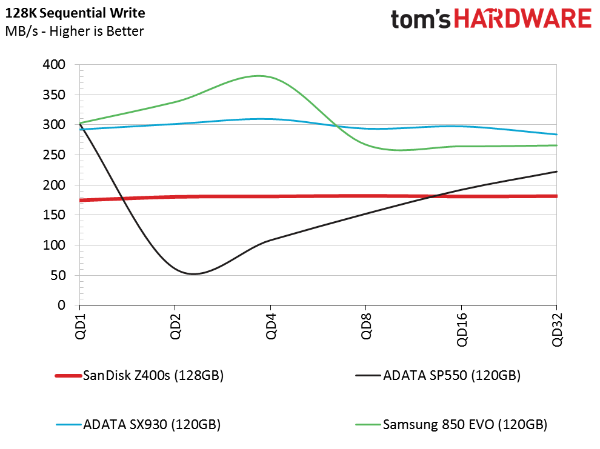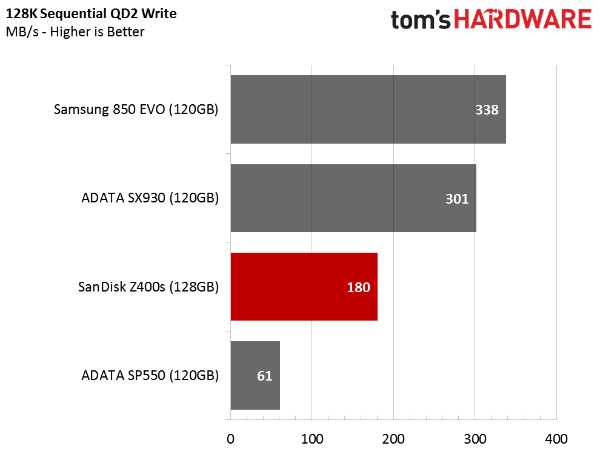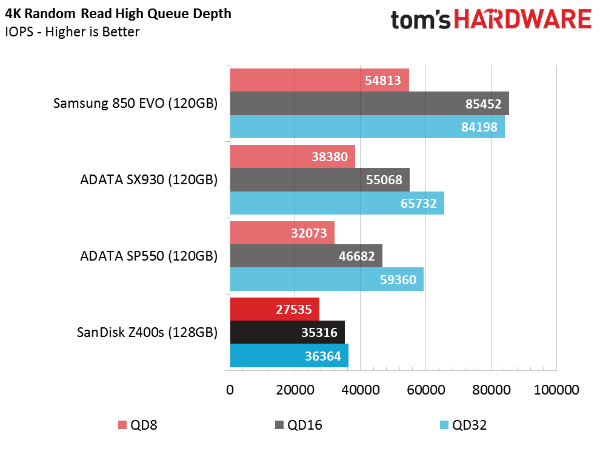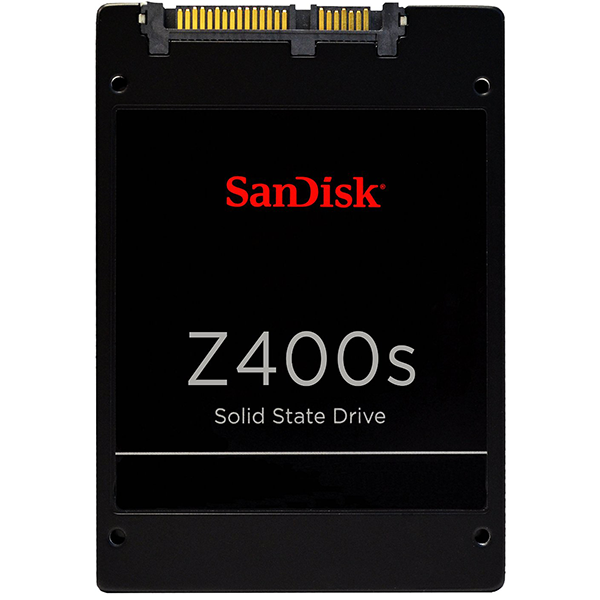SanDisk Z400s SSD Review
SanDisk has the exclusive on Silicon Motion's SM2246XT controller. What's more, we got our 128GB Z400s for just $.25/GB. But is this a true low-cost contender, or just a cheap SSD?
Why you can trust Tom's Hardware
Four-Corner Performance Testing
Sequential Read
To read about our storage tests in-depth, please check out How We Test HDDs And SSDs. Four-corner testing is covered on page six.
Over the last several weeks, we published reviews of low-cost SSDs from a handful of manufacturers. All of them were 256GB-class or larger. We rarely test 128GB-class drives anymore, but we did have a few products that'd compare well to the Z400s. Both of the Adata drives are new and part of the low-performance, low-cost SSD revolution. And Samsung's 850 EVO is a high-performance SSD that sells for a low price. Granted, none of the comparison products sell for the $.25/GB we originally paid for our 128GB Z400s, but they're all cheaper than the Z400s 128GB at the time of writing.


Right off the bat, the Z400s comes out strong in our sequential read test. The DRAM-less drive even outperforms Samsung's 850 EVO 120GB, which is widely regarded as the best low-cost SSD on the market.
Sequential Write


It was fun while it lasted. DRAM keeps the table map data cached for quick updates on where the drive is physically putting data on the flash. Placing the table on slower NAND diminishes its ability to write quickly.
Notice that the Z400s delivers higher sequential numbers than Adata's SP550. This is because the SP550 uses TLC NAND and leans on a small sliver of emulated SLC to mask that technology's native performance.
Random Read



Any operation involving random data is slow on the Z400s. SanDisk's 15nm MLC flash can't make up for the lack of high-speed DRAM, even compared to TLC-based SSDs. At low queue depths, where performance really matters, the Z400s isn't that much slower than the 120GB SP550, though.
Random Write
The Adata SP550 and SanDisk Z400s are evenly matched in measures of random 4KB writes. But both drives show up at around half of the SX930's and 850 EVO's data rates.
Get Tom's Hardware's best news and in-depth reviews, straight to your inbox.
Current page: Four-Corner Performance Testing
Prev Page A Closer Look Next Page Mixed Workload And Steady State
Chris Ramseyer was a senior contributing editor for Tom's Hardware. He tested and reviewed consumer storage.
-
ZolaIII Would actually like to see the 240 GB model & dose it catches up at least reasonable with declared write speeds.Reply
Whole topic is a dead fish until we see first implementation next year that will use 3D XPoint RAM instead of DRAM for caching purposes. -
zodiacfml Nothing to see here except the OEMs who will probably save more by choosing this drive.Reply -
Duken4evr Newegg has Adata 128GB drives on sale for $38. Deal abound out there. OEMs may buy these for cheap so they can advertise their $400 laptop has an SSD, but the rest of us smart shoppers can score deals on better drives for our upgrade purposes.Reply -
Marcus Zettergren Part of the conclusion just doesn't make sense even though i agree the Evo is so much better.Reply
As a potential upgrade, the Z400s is a fairly poor prospect, largely because of its price. In terms of value, Samsung's 850 EVO just wrecks every other company's attempt to compete. With the 128GB Z400s at $45 and the 120GB 850 EVO going for $68, we have to recommend Samsung's offering.
Unless my maths are way off, which it very well could be, the EVO is 62% more/GB. For a gaming disk, the Z400 is just as good as the EVO, and i suspect for a thin ultrabook with a "U" cpu, the cpu will be the bottleneck long before an SSD would be a showstopper. -
photonboy Marcus Zettergren,Reply
Gaming performance (which mainly only affects load times) is but one use case scenario. The CPU isn't going to be the bottleneck either, though low-cost notebooks can be limited by the main chipset of the motherboard, though even then it wouldn't be a total bottleneck but could limit performance.
How the CPU, chipset, and different scenarios work isn't a simple calculation.
I think this is GREAT to have an offering like this. I know fast SSD's seem important to most people but they way my sister uses her PC she wouldn't know the difference. It would still boot up pretty quick and then she's mostly in an office environment.
It's a lot faster than an HDD at times, reasonably inexpensive, and won't take several seconds to come out of standby mode like an HDD. -
nekromobo ReplyIf we want to push solid-state storage into lower-end systems, the expensive DRAM has to go.
According to Anandtech this December 2015:
The average spot price of one 4Gb DDR4 memory chip rated to run at 2133MHz was $2.221 at press time, according to DRAMeXchange,
So for a DRAM in SSD thats 2.221$ well spend (Ok, maybe it increases cost 4$ but anyway...)
Make it DDR3 and youll save 50cents. -
CRamseyer There is a bit more to it than just the physical DRAM. The controller has to have provisions in place for it, the extra design in the PCB, other components to support the DRAM and so on. It all adds up when companies are fighting to find a way to shave off a few Dollars at a time.Reply -
photonboy Reply17193485 said:There is a bit more to it than just the physical DRAM. The controller has to have provisions in place for it, the extra design in the PCB, other components to support the DRAM and so on. It all adds up when companies are fighting to find a way to shave off a few Dollars at a time.
Exactly.
Let's do some more meaningful algebra which I'm making up of course but know to be quite possible:
1) Profit margin of laptop-> $10
2) Savings on SSD (total) vs faster SSD-> $5
Profit is DOUBLED!
Most people will just see that it's an SSD and the capacity on the entry or mid-tier devices this would be aimed for. Saving $5 can make a huge difference in profits since as said they're fighting over scraps a lot of the time.
Some mobile devices were actually just BREAKING EVEN due to the tight competition and price drops. -
uglyduckling81 Reply
1) Profit margin of laptop-> $10
2) Savings on SSD (total) vs faster SSD-> $5
Profit is DOUBLED!
Just tell me again how a $10 profit increased to a $15 profit is double?
